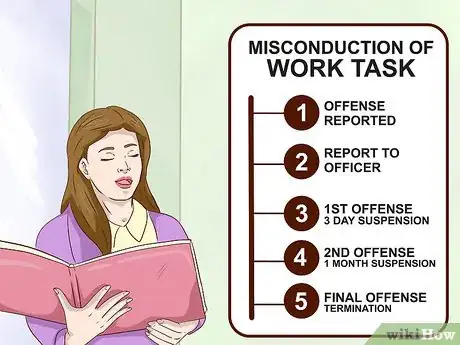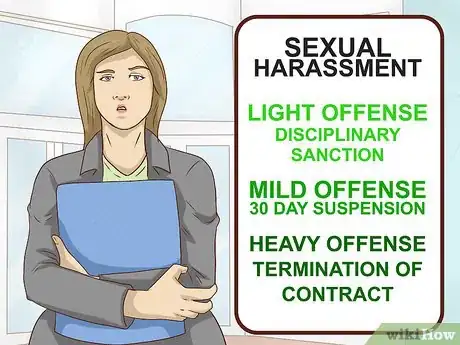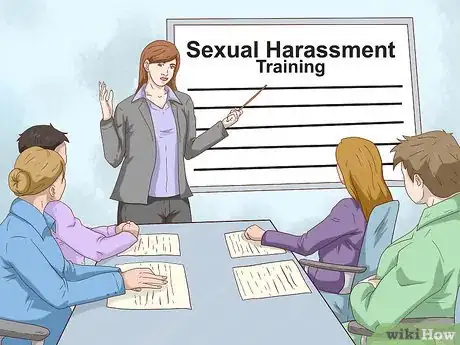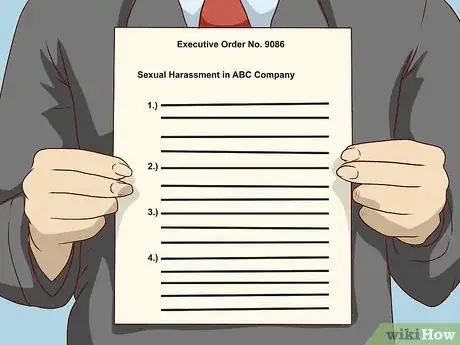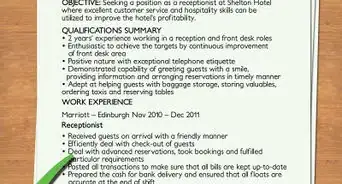This article was co-authored by Jeffrey Fermin and by wikiHow staff writer, Danielle Blinka, MA, MPA. Jeffrey Fermin is a Marketing Manager at AllVoices, an employee feedback management platform. He and the AllVoices team specialize in building a better, safer, more inclusive, and vibrant workplace. Jeffrey holds a Bachelor's degree from Florida International University.
There are 8 references cited in this article, which can be found at the bottom of the page.
This article has been viewed 12,212 times.
Experiencing workplace issues is a normal part of life, but it can still be unpleasant to experience. Whether you’re an employee who needs help from HR or an HR rep responsible for resolving an issue, navigating the HR process can be difficult at first. Fortunately, settling each type of workplace problem is easy once you’ve had a bit of practice. You’ll be able to confront typical HR issues, mediate conflicts, or deal with sexual harassment.
Steps
Confronting Typical HR Issues as an Employee
-
1Attempt to handle issues with coworkers directly before going to HR. When an issue arises, talk to the other party before going to HR.[1] Not only will your HR rep expect you to have attempted to resolve the issue, but you may find that a conversation fixes the problem.[2] Write down what you want to say ahead of time so that you don’t get off-topic during the conversation.
- Say, “Yesterday when you cut me off during the staff meeting, you prevented me from sharing my ideas with the rest of the team. I worked hard on my pitch, but now no one will hear my plan. Can we talk about how to handle this in the future?”
- If you are being harassed, report it to HR immediately. Bring any evidence you have of the harassment.[3]
-
2Document issues you’re having, as well as what was done about them. HR will expect proof of the issue you’re having, so make sure to document what’s happening.[4] It may help to create a file folder to collect your evidence. If you do decide to go to HR, you can present your documentation as support.[5]
- Keep copies of emails, memos, and draft reports that relate to the HR issue.
- Write down the dates of any incidents that occur, as well as what happened and who may have witnessed it.
Advertisement -
3Collect at least 3 examples of bad workplace behavior before reporting. This will demonstrate to HR that there is a problematic behavioral pattern occurring. Some friction between people is normal, so HR is not going to step in if you have a small issue with someone, such as a person who steals your lunch or forgets to reply to 1 email. They’ll want to see examples of multiple issues that are occurring.[6]
- For example, if your coworker routinely sends you inappropriate or rude emails, print them out to show HR.
- If you coworker refuses to complete their share of the work, note when this happens. Attempt to create a paper trail by sending them a friendly email reminder to submit the work.
- When it comes to harassment, it’s a good idea to talk to HR even if there’s only been 1 incident.
-
4Prepare yourself to deliver your side in advance. Practice explaining the issue to HR before you actually go in to talk to them. Make sure that you present a unified case for your side of the issue and that you aren’t forgetting anything. It may help to write down what you want to say or at least make an outline.[7]
- Try to get any emotions out of the way during your preparation. When you talk to HR, you need to keep your emotions in check. Crying or getting angry can hurt your cause.
-
5Use “I” statements. “I” statements keep the focus on what you’re thinking and experiencing rather than putting it off on the other person. Not only will this make your description of the events appear more objective, it also helps you keep your emotions from boiling over.[8]
- Say, “I had to complete both parts of the project in order to meet the deadline, when I was only responsible for one part.”
- Don’t say, “You didn’t do your part, so I had to do your work for you.”
-
6Focus on improving the future rather than punishing the past. There are 2 or more sides to every story, and it’s likely that your employer will expect you and the other party to resolve the issue and move on. While you might want there to be a consequence for the issue, that’s unlikely to happen. Rather than asking for punitive measures, suggest solutions for avoiding problems in the future.[9]
- Collaborate with your coworker to come up with solutions.[10]
-
7Keep accurate records throughout the process. Document all meetings, interventions, communications between parties, and resolutions. Not only will this help keep track of the issue, it can also help address recurring problems in the workplace. For example, if one person is involved in multiple disputes, then it will be helpful to have records of each individual issue.[11]
- All parties should keep accurate records.
Mediating a Conflict
-
1Acknowledge the issue. Each person involved in the conflict should acknowledge the core issue with the help of the HR rep. This will help the parties start communicating about how each view the situation. Understanding each point of view could resolve the issue. If not, the dialogue will help with finding solutions.[12]
-
2Identify the real problem. The real problem is at the root of the issue and is what causes the parties involved to react negatively to what’s happening in the workplace.[13] For example, a coworker who doesn’t return emails in a timely manner may be the issue, but uncertainty about the project that is causing delays may be the real problem. Knowing what is really bothering the people involved is necessary in order to find a solution.[14]
- Ask the party making the complaint why the issue bothers them and how fixing it would improve their work.
- Say, “How does this issue affect your work?” and “What would happen if this were resolved?”
-
3Listen to all parties involved. Even if one person appears to be in the wrong, hear both parties out. It’s possible that there has been a misunderstanding or that the offender has good reasons behind their behaviors. This also allows the employees involved to understand the other person’s side, which can help resolve negative feelings between them. Additionally, hearing all sides will help you come to a collaborative solution to the problem.[15]
-
4Highlight where the parties agree. Most likely both parties have some overlap between their perspectives, so look for the common ground. Try to narrow down the problem by pointing out agreements so that you can focus on finding solutions to the problem at hand.[16]
- You could say, “It sounds like we all agree that the client should come first and great communication is essential for getting projects completed on time.”
-
5Decide what both the individuals and the organization need. This will help successfully resolve the issue. Once you know the real problem, you can figure out what each party needs to feel better. For example, the person filing the complaint may need better communication, more support on shared projects, or fewer interruptions during work hours. The other party may need defined expectations, a flexible schedule, or a notification when their behavior is a distraction. Knowing these needs points to a solution.[17]
- For example, the parties might agree to answer all work emails before the end of the day, or they could agree to assign shared work at the beginning of a project.
-
6Look for solutions to disagreements. Solutions should be a collaboration between both parties and, if needed, the HR rep. Choose solutions that address the needs of both employees and the organization. It’s best if everyone walks away from the meeting feeling like they won something.[18]
- For example, both employees could agree to respond to emails by the end of the workday. This may help the person who filed the complaint feel like they won’t be left hanging when they send an email, while the other party will have the flexibility to wait until the end of the day if necessary.
-
7Establish a plan of action. Write down the solutions identified during the meetings, as well as who is responsible for what. Determine consequences for not upholding the responsibilities discussed in the mediation and document them so that they are fulfilled if necessary.[19]
- Create a timeline of when solutions will be implemented and when consequences will begin to occur.
Dealing With Sexual Harassment as an HR Rep
-
1Take all complaints seriously. Any complaint should be investigated thoroughly and resolved, no matter your opinion on the issue. If someone feels harassed, then it’s a workplace issue that needs to be addressed.[20]
- If you don’t take complaints seriously, then legal actions could occur.
-
2Interview all persons involved, as well as any witnesses. It’s important to get all sides of the story before you take action. While you need to address the complaint, it’s possible that the offender doesn’t realize what they’re doing. You need to get the full story so that you can determine the best way to resolve the issue.[21]
- Witnesses can go a long way in resolving he said, she said issues.
- Even if the offender didn’t realize they were harassing someone, the behavior still needs to be addressed.
-
3Determine if harassment occurred and how severe it is. Use the evidence you collected and the interviews to decide if the actions warrant sexual harassment. If they do, you should follow your company’s policies for handling the issue. You could also consult the Equal Employment Opportunity Commission’s (EEOC) sexual harassment materials to understand the company’s responsibilities.[22]
-
4Decide how to resolve the issue. Even if you find that harassment did not occur, you need to address the situation with the employee who made the complaint. The correct resolution will depend on what occurred and how it impacted the workplace and the parties involved.[23]
- Provide documentation of your investigation to the person who made the complaint.
- For minor issues or findings that harassment has not occurred, talk to the offender about their behavior and what is expected from them in the future.
- If your company has set consequences for sexual harassment, follow them. If not, follow the recommendations of the EEOC or the company’s legal team.
-
5Retrain staff, if needed. In many cases, the staff should go through sexual harassment training to ensure that everyone understands the behavioral expectations in the workplace. Not only could this help prevent future incidents, but it also helps protect the employer from liability because it shows employees that sexual harassment will not be tolerated.[24]
- Ask each person to sign-in or complete a document that proves they were in the training you offered. For example, you could have them take a short quiz to prove that the training occurred and conveyed the message that harassment is not okay.
-
6Prepare a written sexual harassment policy if one does not exist. Most organizations have a written sexual harassment policy, but if yours doesn’t then it’s the responsibility of HR to provide one. Consult online resources to help you prepare one that explains to employees what they can and cannot do in the workplace. Make this document available to all employees.[25]
- It’s a good idea to present the material to employees if you haven’t already, and you should also have them sign off stating that they received it.
Community Q&A
-
QuestionHow can I deal with a distracting and loud coworker?
 Julia Yacoob, PhDDr. Julia Yacoob is a Licensed Clinical Psychologist practicing in New York City. She specializes in Cognitive Behavioral Therapy (CBT) for adults coping with a variety of symptoms and life stressors. Dr. Yacoob earned an MS and Ph.D. in Clinical Psychology from Rutgers University, and pursued specialized training at Weill Cornell Medical College, New York Presbyterian Hospital, Memorial Sloan-Kettering Cancer Center, the Institute for Behavior Therapy, and Bellevue Hospital Cancer Center. Dr. Yacoob is a member of the American Psychological Association, Women’s Mental Health Consortium, NYC Cognitive Behavioral Therapy Association, and Association for Cognitive and Behavioral Therapies.
Julia Yacoob, PhDDr. Julia Yacoob is a Licensed Clinical Psychologist practicing in New York City. She specializes in Cognitive Behavioral Therapy (CBT) for adults coping with a variety of symptoms and life stressors. Dr. Yacoob earned an MS and Ph.D. in Clinical Psychology from Rutgers University, and pursued specialized training at Weill Cornell Medical College, New York Presbyterian Hospital, Memorial Sloan-Kettering Cancer Center, the Institute for Behavior Therapy, and Bellevue Hospital Cancer Center. Dr. Yacoob is a member of the American Psychological Association, Women’s Mental Health Consortium, NYC Cognitive Behavioral Therapy Association, and Association for Cognitive and Behavioral Therapies.
Clinical Psychologist You can talk to the coworker and arrive at a solution. Otherwise, move to another desk or space in the office.
You can talk to the coworker and arrive at a solution. Otherwise, move to another desk or space in the office. -
QuestionWhat is the benefit of admitting your mistakes?
 Julia Yacoob, PhDDr. Julia Yacoob is a Licensed Clinical Psychologist practicing in New York City. She specializes in Cognitive Behavioral Therapy (CBT) for adults coping with a variety of symptoms and life stressors. Dr. Yacoob earned an MS and Ph.D. in Clinical Psychology from Rutgers University, and pursued specialized training at Weill Cornell Medical College, New York Presbyterian Hospital, Memorial Sloan-Kettering Cancer Center, the Institute for Behavior Therapy, and Bellevue Hospital Cancer Center. Dr. Yacoob is a member of the American Psychological Association, Women’s Mental Health Consortium, NYC Cognitive Behavioral Therapy Association, and Association for Cognitive and Behavioral Therapies.
Julia Yacoob, PhDDr. Julia Yacoob is a Licensed Clinical Psychologist practicing in New York City. She specializes in Cognitive Behavioral Therapy (CBT) for adults coping with a variety of symptoms and life stressors. Dr. Yacoob earned an MS and Ph.D. in Clinical Psychology from Rutgers University, and pursued specialized training at Weill Cornell Medical College, New York Presbyterian Hospital, Memorial Sloan-Kettering Cancer Center, the Institute for Behavior Therapy, and Bellevue Hospital Cancer Center. Dr. Yacoob is a member of the American Psychological Association, Women’s Mental Health Consortium, NYC Cognitive Behavioral Therapy Association, and Association for Cognitive and Behavioral Therapies.
Clinical Psychologist Your connection with people will be honest. People will understand you better. If you hurt somebody and acknowledge your mistake, you will gain long-term benefits.
Your connection with people will be honest. People will understand you better. If you hurt somebody and acknowledge your mistake, you will gain long-term benefits.
References
- ↑ Julia Yacoob, PhD. Clinical Psychologist. Expert Interview. 15 July 2021.
- ↑ Jeffrey Fermin. Marketing Manager, AllVoices. Expert Interview. 11 July 2022.
- ↑ https://www.forbes.com/sites/lisaroepe/2017/02/14/4-workplace-issues-hr-wants-you-to-handle-on-your-own/#6ea1a26320c4
- ↑ Jeffrey Fermin. Marketing Manager, AllVoices. Expert Interview. 11 July 2022.
- ↑ http://topics.hrhero.com/problem-employees/#
- ↑ https://www.forbes.com/sites/lisaroepe/2017/02/14/4-workplace-issues-hr-wants-you-to-handle-on-your-own/#6ea1a26320c4
- ↑ https://hr.utexas.edu/current/services/problem-solving
- ↑ https://hr.utexas.edu/current/services/problem-solving
- ↑ https://hr.utexas.edu/current/services/problem-solving
- ↑ Julia Yacoob, PhD. Clinical Psychologist. Expert Interview. 15 July 2021.
- ↑ https://www.hrzone.com/community/blogs/jamessheehan/top-10-issues-for-hr-teams-how-to-fix-them
- ↑ https://hr.berkeley.edu/hr-network/central-guide-managing-hr/managing-hr/interaction/conflict/resolving
- ↑ Julia Yacoob, PhD. Clinical Psychologist. Expert Interview. 15 July 2021.
- ↑ https://hr.berkeley.edu/hr-network/central-guide-managing-hr/managing-hr/interaction/conflict/resolving
- ↑ https://hr.berkeley.edu/hr-network/central-guide-managing-hr/managing-hr/interaction/conflict/resolving
- ↑ https://hr.berkeley.edu/hr-network/central-guide-managing-hr/managing-hr/interaction/conflict/resolving
- ↑ https://hr.berkeley.edu/hr-network/central-guide-managing-hr/managing-hr/interaction/conflict/resolving
- ↑ https://hr.berkeley.edu/hr-network/central-guide-managing-hr/managing-hr/interaction/conflict/resolving
- ↑ https://hr.berkeley.edu/hr-network/central-guide-managing-hr/managing-hr/interaction/conflict/resolving
- ↑ http://money.cnn.com/2017/04/10/pf/jobs/workplace-sexual-harassment/index.html
- ↑ http://money.cnn.com/2017/04/10/pf/jobs/workplace-sexual-harassment/index.html
- ↑ http://money.cnn.com/2017/04/10/pf/jobs/workplace-sexual-harassment/index.html
- ↑ http://money.cnn.com/2017/04/10/pf/jobs/workplace-sexual-harassment/index.html
- ↑ http://money.cnn.com/2017/04/10/pf/jobs/workplace-sexual-harassment/index.html
- ↑ http://money.cnn.com/2017/04/10/pf/jobs/workplace-sexual-harassment/index.html















